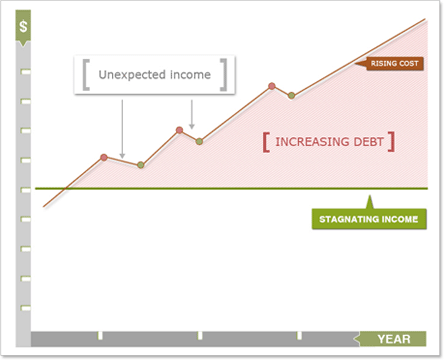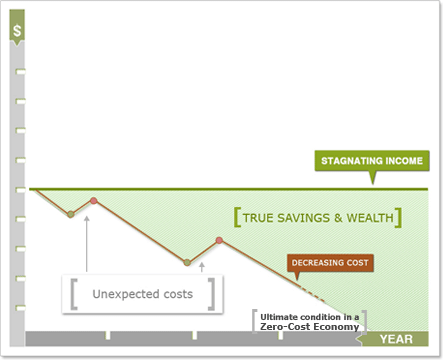| |
|
|
|
 |
 |
Typical economic conditions
in a capitalistic economic system |
 |
Economic condition
in a Zero-Cost Economy |
 |
 |
With either a capitalist or socialist economic system, a devastating phenomenon occurs: Costs increase while purchasing power declines permanently, as graph #1 clearly shows. Although this graph depicts stagnating incomes with permanently increasing costs, a similar decline in purchasing power accompanied by increasing debt occurs with increasing incomes if those incomes don't grow faster than costs. In an inflationary economy, purchasing power declines regardless of income increases; in other words, the purchasing power of a dollar (or any other currency) falls rather than stays the same.
Savings and wealth can't accumulate unless purchasing power increases. But how can we increase our purchasing power? Normally, this can be done either through steady increases in income (which must always exceed costs) or through cost reduction, even if incomes stagnate. Logically, a simultaneous rise in income along with cost reduction would boost purchasing power that much more. To be clear, cost reductions shouldn't be achieved at the expense of a decreased standard of living. On the contrary, they must be achieved by improving the standard of living, as described in Towards a Zero-Cost Economy.
(Click here to download).
Initially, a zero-cost economy may seem to be deflationary. However, this appearance is deceiving, because a conventional deflationary economy is marked by a shortage of money and credit, declining inventory, dropping prices, increasing unemployment, a stagnating economy, and massive bankruptcies, which can ravage the economy even more than inflation can. In this situation, the economy and the people are virtually broke – poised at the edge of the proverbial cliff.
In contrast, in a zero-cost economy, people will own their homes, vehicles, energy delivery systems, and everything else. The same holds true for businesses and the government. They won't be riding a rollercoaster economy, subject to booms and busts. They will enjoy a carefree economic security and true ownership, as described in Toward a Zero-Cost Economy.
As graph #2 shows, the beauty of a zero-cost economy is that it creates true wealth, which brings economic security and paves the way for a transition to a leisure- and knowledge-based society. As a result, economic slavery ends and people start enjoying life without daily financial pressures. If instead we fail to increase general purchasing power by controlling costs, economic security will elude us. By itself, creating new jobs can't achieve these important goals.
|
|
|
|